15 years one-stop China custom CNC machining parts factory
 225 |
Published by VMT at Jul 28 2025 | Reading Time:About 6 minutes
225 |
Published by VMT at Jul 28 2025 | Reading Time:About 6 minutes
Choosing the right steel for high-performance tools or precision parts is a challenge for both engineers and manufacturers. With so many advanced steel grades on the market, confusion often arises—especially when comparing closely matched materials like MC66 steel and SG2 steel. Both are renowned for their excellent performance in demanding applications such as cutlery, precision tools, and CNC machining components. However, the differences between them can impact product performance, longevity, and cost-efficiency. If you're unsure which to choose, you're not alone. The good news? This article offers a clear, comprehensive comparison between MC66 steel and SG2 steel, helping you make informed material decisions tailored to your application.
The key difference between MC66 steel and SG2 steel lies in their chemical composition and mechanical performance. MC66 steel offers enhanced wear resistance and edge retention, making it ideal for high-end knives, while SG2 steel excels in toughness and corrosion resistance. Choosing between them depends on your application’s priority: durability, machinability, or cutting performance.
For buyers, engineers, and procurement specialists working with CNC machining factories, understanding these steel types is critical. By examining their properties, costs, advantages, and common applications, you can ensure that your product achieves optimal performance, whether you're sourcing MC66 steel CNC machining parts or SG2 steel CNC machining parts. Let’s explore these two advanced steels in depth.
Key Points (Quick Summary for Intuitive Understanding)
MC66 steel is a high-end stainless steel primarily used in premium cutting tools and specialty steel CNC machining parts. Developed for exceptional hardness, MC66 is a proprietary formulation, typically categorized alongside high-carbon stainless steels with enhanced molybdenum and vanadium content. These alloying elements contribute to its outstanding wear resistance and edge retention, making it ideal for long-lasting blades and industrial tooling. In CNC machining, MC66 steel requires precision programming and high-speed tooling due to its hardness, but it yields finely detailed and durable parts when processed correctly.
Its primary strengths lie in applications where cutting performance, dimensional stability, and long service life are essential. Although less corrosion-resistant than some powder metallurgy steels, MC66 holds its edge longer, making it a preferred material in performance-critical environments such as aerospace parts, medical instruments, and custom CNC knife production. Leading CNC machining factories recommend MC66 steel CNC machining parts when precision and hardness are top priorities.
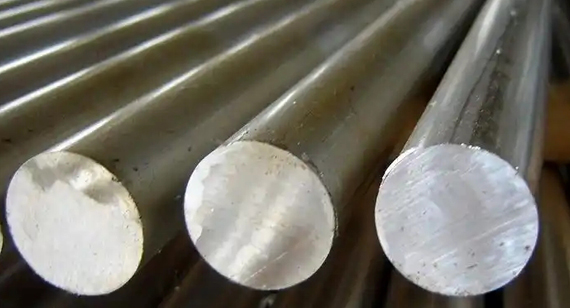
SG2 steel, also known as Super Gold 2, is a premium powder metallurgy stainless steel developed in Japan. Produced using a powder process, SG2 boasts a fine and uniform grain structure that enhances its mechanical properties. This steel is especially noted for its balance of hardness, corrosion resistance, and toughness. SG2 steel CNC machining parts are frequently chosen in industries where strength and reliability under stress are crucial—such as high-end kitchen knives, surgical tools, and marine equipment.
Compared to traditional stainless steels, SG2 offers better edge retention without sacrificing ease of sharpening. It also resists pitting and rust in humid or acidic environments, making it a favorite among knife makers and CNC machining service providers focused on food-grade or medical-grade components. Thanks to its consistent structure, SG2 machines cleanly and responds well to precision operations, which is why many CNC machining factories list SG2 steel among their top material offerings.

At first glance, MC66 steel and SG2 steel may appear similar, especially since both are high-performance stainless steels often used in premium knives and precision CNC machining parts. However, the main difference lies in their manufacturing process, chemical composition, and resulting mechanical performance, which ultimately defines how they perform under specific conditions.
MC66 steel is typically classified as a high-carbon, high-alloy stainless steel that emphasizes maximum hardness, edge retention, and wear resistance. It is formulated to maintain sharp edges for extended periods, even under intense cutting or wear-intensive operations. The trade-off, however, is slightly reduced toughness and corrosion resistance compared to SG2. MC66 is generally manufactured using traditional steelmaking methods, though some variations may incorporate powder metallurgy techniques for performance optimization. This steel is favored when edge stability and cutting precision are paramount—ideal for blades, dies, and fine-detailed CNC machining applications.
On the other hand, SG2 steel is a powder metallurgy stainless steel produced using an advanced process that ensures a fine, uniform grain structure. This results in excellent toughness, corrosion resistance, and ease of sharpening, while still offering commendable hardness. SG2 steel’s composition is richer in chromium and molybdenum, giving it superior performance in humid, corrosive, or high-wear environments. SG2 steel CNC machining parts are widely appreciated for their structural consistency, which enhances both machinability and long-term durability.
In summary:
Choosing between MC66 steel and SG2 steel depends largely on the application’s specific requirements—whether it demands ultra-hardness and cutting performance (MC66) or a balanced steel with great toughness and corrosion resistance (SG2).
Here is a clear comparison table summarizing the main differences between MC66 steel and SG2 steel based on key performance and production criteria:
| Feature |
MC66 Steel |
SG2 Steel |
| Steel Type |
High-carbon stainless steel (may use traditional or hybrid PM methods) | Powder metallurgy (PM) stainless steel |
| Hardness |
Higher (typically ~62–64 HRC) | Slightly lower (typically ~60–62 HRC) |
| Edge Retention |
Superior – maintains a sharp edge longer | Very good – sharp but not as long-lasting as MC66 |
| Toughness |
Moderate – can chip under impact | Excellent – resists chipping and breakage |
| Corrosion Resistance |
Good – suitable for dry or controlled environments | Excellent – ideal for humid, acidic, or wet environments |
| Wear Resistance |
Very high – resists abrasion under repeated use | High – but slightly below MC66 |
| Ease of Sharpening |
More difficult – due to high hardness | Easier – fine microstructure makes sharpening smoother |
| Machinability (CNC) |
Requires precise CNC machining tools and settings | Better machinability due to uniform grain structure |
| Common Uses |
High-end knives, cutting tools, wear-resistant parts, MC66 steel CNC parts | Kitchen knives, medical tools, marine equipment, SG2 steel CNC parts |
| Processing Method |
Mostly traditional forging with some hybrid PM | Powder metallurgy (fine powder compaction and sintering) |
| Cost Level |
High – due to alloy complexity and performance | High – due to advanced PM process |
| CNC Machining Suitability |
Used for highly detailed, wear-resistant parts in specialized CNC machining | Preferred for corrosion-resistant, high-toughness CNC machining applications |
This table helps users quickly determine which material is more appropriate for their application—whether they’re sourcing steel CNC machining parts or evaluating knife-grade stainless steels.
Both MC66 steel and SG2 steel are premium-grade materials used in the production of high-performance knives and steel CNC machining parts, but they exhibit distinct metallurgical profiles that result in different mechanical behaviors. These differences are rooted in their chemical composition and production process—which directly influence hardness, toughness, corrosion resistance, and machinability.
MC66 steel is engineered for superior hardness and cutting edge retention, often at the expense of some toughness. It typically contains a high percentage of carbon and chromium, along with vanadium and molybdenum, which enhance wear resistance and grain refinement. This makes it an excellent choice for applications where precision cutting and long service life are required, such as MC66 steel CNC machining parts for surgical instruments or performance knives.
SG2 steel, by contrast, is a powder metallurgy stainless steel that focuses on a balanced combination of toughness, hardness, and corrosion resistance. With a high chromium and molybdenum content and a fine microstructure from its PM manufacturing, SG2 maintains high stability under mechanical and environmental stress. These features make it well-suited for SG2 steel CNC machining parts where both form and function are equally important—especially in humid, corrosive, or high-impact conditions.
Understanding the chemical composition of each alloy is essential for engineers and buyers working with CNC machining factories, ensuring optimal material selection for the intended function and environment.
MC66 Steel vs. SG2 Steel: Chemical Composition
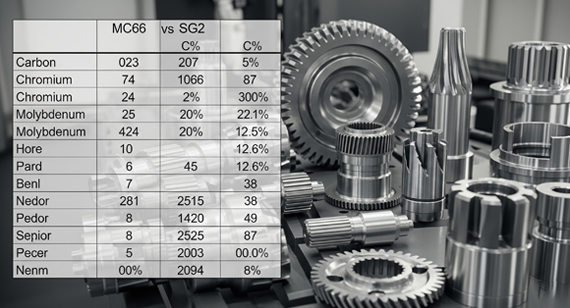
The table below compares the typical chemical composition of MC66 steel and SG2 steel. Actual percentages can vary slightly depending on the specific manufacturer or proprietary formulation.
| Element |
MC66 Steel (Typical Range) |
SG2 Steel (Typical Range) |
| Carbon (C) |
1.00 – 1.10% | 1.25 – 1.45% |
| Chromium (Cr) |
14.00 – 15.50% | 14.00 – 16.00% |
| Iron (Fe) |
Balance | Balance |
| Manganese (Mn) |
0.30 – 0.60% | 0.20 – 0.50% |
| Molybdenum (Mo) |
1.00 – 1.50% | 2.30 – 3.30% |
| Nickel (Ni) |
0.50 – 1.00% | ≤ 0.25% |
| Nitrogen (N) |
≤ 0.10% | ≤ 0.15% |
| Phosphorus (P) |
≤ 0.030% | ≤ 0.030% |
| Silicon (Si) |
0.50 – 0.80% | 0.50 – 0.80% |
| Sulfur (S) |
≤ 0.015% | ≤ 0.010% |
| Vanadium (V) |
0.80 – 1.20% | 1.80 – 2.20% |
Analysis:
This compositional breakdown provides a technical foundation for selecting the right material for CNC machining services, whether you're producing corrosion-resistant SG2 steel components or ultra-sharp MC66 steel parts.
MC66 Steel vs. SG2 Steel: Mechanical Properties
In high-performance applications—especially in CNC machining services, knife manufacturing, and industrial tool production—mechanical properties determine how well a material performs under stress, wear, and impact. When comparing MC66 steel and SG2 steel, it’s essential to evaluate their core mechanical characteristics. These properties include hardness, strength, ductility, fatigue resistance, and more. Understanding these factors is crucial when choosing between MC66 steel CNC machining parts and SG2 steel CNC machining parts.
MC66 steel is engineered for high hardness and edge retention. It excels in environments that demand prolonged cutting, wear resistance, and precision retention. However, this higher hardness often results in reduced ductility and lower impact resistance.
SG2 steel, developed through powder metallurgy, offers a more balanced profile. While still hard, it maintains greater toughness and resistance to fatigue and thermal stress, making it well-suited for demanding, variable environments. Its fine-grain structure enhances fatigue performance and reduces the risk of microcracks during machining or repeated use.
Below is a side-by-side comparison of the mechanical properties of MC66 and SG2 steel, which are especially relevant to designers, engineers, and procurement managers working with CNC machining factories.
Mechanical Properties Comparison Table: MC66 Steel vs. SG2 Steel
| Property |
MC66 Steel (Typical) |
SG2 Steel (Typical) |
| Hardness (HRC) |
62 – 64 HRC | 60 – 62 HRC |
| Hardness (HV) |
~800 – 850 HV | ~750 – 800 HV |
| Hardness (HRC/HRB) |
HRC scale | HRC scale |
| Tensile Strength (MPa) |
1,900 – 2,100 MPa | 1,600 – 1,800 MPa |
| Elongation Strength (Rp0.2/MPa) |
~1,400 MPa | ~1,200 MPa |
| Ductility (%) |
~4 – 6% | ~8 – 10% |
| Yield Strength |
~1,500 MPa | ~1,250 MPa |
| Reduction of Area (Z/%) |
~20% | ~30% |
| Heating Temperature (°C) |
950 – 1050°C (annealing range) | 950 – 1100°C (annealing range) |
| Elastic Modulus (GPa) |
~200 GPa | ~190 – 200 GPa |
| Elongation at Break (%) |
4 – 6% | 8 – 10% |
| Fatigue Strength (MPa) |
~500 MPa | ~600 MPa |
| Poisson's Ratio |
~0.30 | ~0.29 – 0.30 |
| Shear Modulus (GPa) |
~80 GPa | ~75 – 80 GPa |
| Shear Strength (MPa) |
~1000 MPa | ~900 – 950 MPa |
Analysis:
This detailed breakdown enables users to make data-driven decisions when selecting materials for steel CNC machining parts, particularly in performance-critical industries like aerospace, medical, and custom tooling.
MC66 Steel and SG2 Steel: Physical Properties
When selecting materials for high-performance applications—especially for CNC machining services, precision cutting tools, or industrial components—understanding physical properties is essential. These properties affect how the material behaves under temperature changes, electrical loads, and environmental exposure. Both MC66 steel and SG2 steel are classified as stainless steels, but they differ in structure and performance due to their respective compositions and manufacturing methods.
MC66 steel is generally produced using conventional high-alloy processes with an emphasis on edge retention and hardness. It features good thermal stability but moderate corrosion resistance. Its physical attributes make it ideal for dry environments or applications requiring high-precision cuts, such as MC66 steel CNC machining parts used in tooling, surgical blades, and performance knives.
SG2 steel, a product of powder metallurgy, has a more refined microstructure, contributing to better toughness, corrosion resistance, and more consistent physical performance. It's well-suited for humid, corrosive, or thermally dynamic environments, making SG2 steel CNC machining parts popular in food processing, marine tools, and medical components.
Below is a comparative table highlighting the key physical properties of MC66 and SG2 steel to guide material selection in engineering and CNC machining contexts.
Physical Properties Comparison Table: MC66 Steel vs. SG2 Steel
| Property |
MC66 Steel (Typical) |
SG2 Steel (Typical) |
| Density (g/cm³) |
~7.80 | ~7.95 |
| Melting Point (°C) |
~1400 – 1450°C | ~1350 – 1400°C |
| Specific Heat Capacity (J/kg·K) |
~460 | ~500 |
|
Thermal Conductivity (W/m·K) |
~22 – 25 | ~20 – 23 |
| Thermal Expansion (Linear, 10⁻⁶/K) |
~10 – 11 | ~10 – 11.5 |
| Resistivity (μΩ·m) |
~0.60 – 0.70 | ~0.65 – 0.75 |
| Longitudinal Elastic Modulus (kN/mm²) |
~200 | ~190 – 200 |
| Magnetic Properties |
Slightly magnetic | Slightly magnetic to non-magnetic |
| Conductivity (Relative to Cu) |
Low | Low |
| Rust Resistance |
Moderate – good in dry settings | High – excellent in humid/wet areas |
| Toughness |
Moderate | High |
| Corrosion Resistance |
Good, but lower than SG2 | Excellent |
Analysis:
In summary, MC66 steel is the right choice for applications that prioritize sharpness, wear resistance, and structural integrity, while SG2 steel is the superior option for corrosion resistance, physical stability, and toughness. These traits are crucial for steel CNC machining parts, especially in industries like medical, aerospace, and high-end consumer tools.
Heat treatment plays a critical role in defining the final mechanical and physical performance of both MC66 steel and SG2 steel. In CNC machining services and knife manufacturing industries, proper heat treatment ensures that the material reaches its desired hardness, toughness, and dimensional stability. Although both steels are stainless and engineered for high-performance use, their heat treatment requirements and outcomes differ due to their metallurgical structures.
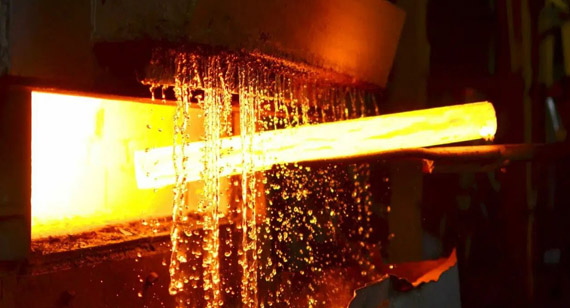
Heat Treatment of MC66 Steel
MC66 steel is a high-carbon, high-alloy stainless steel that undergoes traditional heat treatment procedures, which typically include austenitizing, quenching, and tempering. These processes are essential for achieving its remarkable hardness (up to 64 HRC) and excellent edge retention, especially in applications such as MC66 steel CNC machining parts used in precision tools and performance blades.
During quenching, MC66 forms a martensitic structure that maximizes its hardness. The tempering stage must be carefully controlled to avoid brittleness while retaining strength. Over-tempering can lead to a loss of edge sharpness, especially in fine cutting tools.
Heat Treatment of SG2 Steel
SG2 steel, as a powder metallurgy stainless steel, benefits from a more refined heat treatment process that aligns with its homogeneous microstructure. The powder metallurgy allows SG2 to respond well to thermal cycles, providing a balance of toughness, hardness (~60–62 HRC), and corrosion resistance. This makes SG2 steel CNC machining parts suitable for medical, food-grade, or high-impact applications.
SG2’s heat treatment typically results in a finer carbide distribution and enhanced grain stability, which improves fatigue resistance and long-term performance. The precision required for SG2’s heat treatment is slightly higher, making it more common in CNC machining factories that specialize in PM-grade materials.
Comparison Summary
| Heat Treatment Factor |
MC66 Steel |
SG2 Steel |
| Process Type |
Traditional (Austenitize → Quench → Temper) | Advanced PM-compatible thermal processing |
| Max Hardness After HT |
~64 HRC | ~62 HRC |
| Toughness After HT |
Moderate | High |
| Temper Sensitivity |
Higher – risk of brittleness | Lower – more forgiving due to PM structure |
| Common Application Post-HT |
High-precision knives, dies, tools | High-toughness parts, surgical blades, food tools |
| CNC Machining Suitability Post-HT |
Needs rigid tooling due to hardness | Easier to machine post-HT due to finer grains |
Proper heat treatment maximizes the value of both MC66 and SG2 steel. While MC66 prioritizes hardness and wear resistance, SG2 aims for a tough, corrosion-resistant profile. CNC machining factories must consider these thermal behaviors to produce precise, long-lasting steel CNC machining parts tailored to specific industries.
When selecting materials for precision cutting tools, high-end knives, or steel CNC machining parts, understanding the advantages and disadvantages of each option is crucial for engineers, product designers, and procurement teams. MC66 steel and SG2 steel are both premium stainless steels used in performance-critical applications—but each has strengths and trade-offs that should be evaluated based on the product’s intended environment, usage, and life cycle expectations.
In this section, we’ll explore the pros and cons of both steels in terms of performance, machinability, cost, durability, and more—helping you decide which material is more suitable for your next CNC machining or manufacturing project.
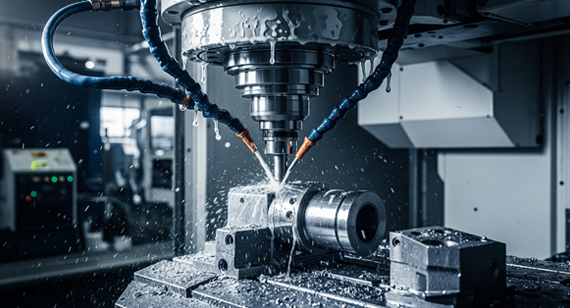
Advantages and Disadvantages of MC66 Steel
MC66 steel is a high-carbon stainless steel designed for maximum hardness and edge retention. It is often used in knife manufacturing, medical tools, and specialty MC66 steel CNC machining parts where cutting precision and wear resistance are critical. While it excels in these areas, there are also limitations in terms of toughness and corrosion performance.
Advantages of MC66 Steel
MC66 steel’s high carbon and vanadium content result in an ultra-hard martensitic structure that holds a sharp edge longer than most steels, making it ideal for knives, precision blades, and dies.
It typically reaches 62–64 HRC after heat treatment, allowing it to resist deformation, abrasion, and wear even under intensive use.
The steel's microstructure resists grinding, friction, and repetitive motion, which is particularly advantageous for steel CNC machining parts used in tooling or high-frequency mechanical components.
Despite its hardness, MC66 can be finely machined with advanced tooling, making it a good candidate for detailed and dimension-critical parts.
Disadvantages of MC66 Steel
The very hardness that makes MC66 attractive also reduces its toughness. It is more prone to chipping or fracturing under sudden impacts or flexing.
Although classified as stainless, its corrosion resistance is lower than SG2 due to its high carbon content and lower molybdenum ratio. It performs best in dry or controlled environments.
Due to its hardness, MC66 steel can be more difficult to sharpen once dulled, requiring diamond stones or professional sharpening systems.
CNC machining factories must use advanced tooling and precise feeds/speeds when working with MC66 steel, which may increase processing time and cost.
Advantages and Disadvantages of SG2 Steel
SG2 steel—also known as Super Gold 2—is a premium powder metallurgy stainless steel known for its fine microstructure, exceptional corrosion resistance, and overall balanced performance. It is a top-tier choice for SG2 steel CNC machining parts, especially in industries where hygiene, strength, and reliability are critical, such as food processing, healthcare, and marine environments.
Advantages of SG2 Steel
With higher chromium and molybdenum content, SG2 performs exceptionally well in humid, acidic, or salt-exposed environments—ideal for kitchen knives, surgical instruments, or marine-grade components.
SG2’s PM structure provides greater impact resistance and durability, making it less prone to chipping and suitable for dynamic loads and repeated stress.
While slightly softer than MC66 (typically 60–62 HRC), SG2 still holds an edge well and is significantly easier to resharpen, offering both longevity and ease of maintenance.
Thanks to its fine and uniform grain, SG2 is easier to machine, polish, and finish—saving time and cost in CNC machining services.
Disadvantages of SG2 Steel
As a powder metallurgy steel, SG2 is more expensive to produce than conventionally forged steels. This premium cost may not be justifiable in low-budget or non-critical applications.
Although still excellent, SG2 doesn't retain its edge as long as ultra-hard steels like MC66, especially in aggressive cutting tasks.
Improper heat treatment or grinding can degrade its microstructure, so CNC machining factories must apply strict process control during manufacturing.
Due to its specialized production process, SG2 may have limited availability for large-scale industrial projects compared to more mainstream tool steels.
Summary:
Both steels deliver exceptional results when handled correctly by experienced CNC machining factories. The choice ultimately depends on your performance priorities and operating conditions.
Here is a concise table summarizing the advantages and disadvantages of MC66 steel and SG2 steel for quick reference:
| Aspect |
MC66 Steel |
SG2 Steel |
| Advantages | - Superior edge retention and hardness (62–64 HRC) | - Excellent corrosion resistance and toughness |
| - Exceptional wear resistance | - Balanced hardness and easier sharpening (60–62 HRC) | |
| - Suitable for precision machining of wear-resistant parts | - Superior machinability due to fine grain structure | |
| - High dimensional stability in CNC machining | - Ideal for humid, acidic, or corrosive environments | |
| Disadvantages | - Lower toughness, prone to chipping under impact | - Higher material cost due to powder metallurgy process |
| - Moderate corrosion resistance | - Slightly lower edge retention compared to MC66 | |
| - Difficult to sharpen | - Sensitive to overheating during heat treatment and grinding | |
| - More demanding CNC machining requirements, increasing cost | - Limited availability for bulk industrial use |
This table offers a clear overview to help clients and engineers decide between MC66 steel CNC machining parts and SG2 steel CNC machining parts based on their specific project needs and priorities.
Choosing the right steel grade significantly influences the performance, durability, and cost-efficiency of finished products. Both MC66 steel and SG2 steel are premium materials frequently selected for their outstanding properties in demanding applications. Understanding their ideal uses helps engineers, manufacturers, and procurement specialists align material selection with product requirements—especially when sourcing steel CNC machining parts or specialized components through professional CNC machining services.
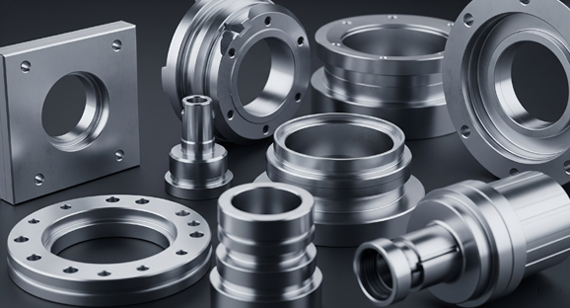
Applications and Uses of MC66 Steel
MC66 steel is prized for its exceptional hardness, wear resistance, and edge retention. These features make it a top choice for applications requiring durable cutting edges or high-strength components that endure repetitive mechanical stress.
MC66 is widely used for premium knives, industrial blades, and surgical instruments that demand long-lasting sharpness and reliability.
Its superior abrasion resistance makes MC66 ideal for wear components in manufacturing equipment, aerospace parts, and precision dies produced by CNC machining factories.
The steel’s ability to hold tight tolerances and withstand repeated mechanical loads suits it well for precision punches, molds, and cutting dies.
MC66’s hardness and ability to maintain a polished surface make it suitable for some specialized medical instruments requiring durability and biocompatibility.
Applications and Uses of SG2 Steel
SG2 steel offers a balanced combination of corrosion resistance, toughness, and hardness, which broadens its usability across environments where reliability and maintenance are critical.
Thanks to its excellent corrosion resistance and ease of sharpening, SG2 is a popular choice among professional and artisan knife makers.
SG2 steel’s biocompatibility, resistance to rust, and toughness make it ideal for surgical tools that require repeated sterilization and use.
Its resistance to moisture and corrosion suits components exposed to marine environments or humid conditions.
SG2’s hygienic properties and corrosion resistance make it favored for parts in food-grade steel CNC machining parts produced by CNC machining factories serving the food industry.
The fine microstructure of SG2 allows for smooth machining of complex parts requiring tight tolerances and long-term durability.
Summary
| Steel Type |
Key Applications |
Typical Uses |
| MC66 Steel |
Cutting tools, wear-resistant parts, medical devices | Industrial blades, aerospace parts, precision dies, surgical tools |
| SG2 Steel |
Corrosion-resistant tools, marine, food, medical | Kitchen knives, surgical instruments, marine equipment, food processing machinery |
For companies seeking CNC machining services, selecting between MC66 steel CNC machining parts or SG2 steel CNC machining parts depends on whether priority lies in maximum wear resistance and edge retention (MC66) or in toughness combined with corrosion resistance (SG2). Both steels are supported by top-tier CNC machining factories, ensuring quality and precision in the final products.
In the world of high-performance steels, cost is a critical factor for manufacturers, engineers, and procurement professionals. While performance characteristics are paramount, understanding both the initial investment and long-term cost-effectiveness of materials like MC66 steel and SG2 steel ensures smarter purchasing decisions. This is especially important when sourcing steel CNC machining parts or commissioning complex components through professional CNC machining factories.
Initial Cost Comparison
MC66 steel is generally priced competitively within the high-end stainless steel category. Its traditional manufacturing process and alloy composition keep the material cost relatively stable and accessible compared to powder metallurgy steels. However, the hardness and wear resistance that MC66 delivers often require specialized CNC machining tools and longer machining times, which can increase the overall processing cost.
In contrast, SG2 steel, produced through a powder metallurgy (PM) process, carries a higher initial price due to its advanced manufacturing technique. The PM process ensures a fine, consistent microstructure but involves more complex production steps and higher raw material costs. Additionally, SG2’s premium corrosion resistance and balanced mechanical properties position it as a luxury-grade steel, often reflected in its market price.
Long-Term Cost-Effectiveness
When evaluating long-term costs, MC66 steel excels in applications where wear resistance and edge retention reduce the need for frequent replacements or sharpening. This durability translates into lower maintenance costs, fewer downtime hours, and longer service life for components such as cutting tools and industrial blades.
SG2 steel, while initially more expensive, can prove cost-effective in environments where corrosion resistance and toughness are critical. Its resistance to rust and chipping means fewer failures or replacements, especially in wet, acidic, or high-impact conditions. The ease of sharpening and maintenance also contributes to lower lifecycle costs for knives, surgical instruments, and marine equipment.
Summary Table: Cost and Price Comparison
| Cost Factor |
MC66 Steel |
SG2 Steel |
| Initial Material Cost |
Moderate – traditional steelmaking process | Higher – advanced powder metallurgy process |
| Machining Cost |
Higher – requires specialized tooling due to hardness | Moderate – better machinability reduces machining time |
| Maintenance Cost |
Lower – superior edge retention reduces sharpening frequency | Moderate – easier to sharpen but may need more frequent maintenance in abrasive environments |
| Replacement Frequency |
Low – durable and wear-resistant | Moderate – high toughness reduces breakage, but edge wears faster |
| Overall Cost-Effectiveness |
High for wear-critical, dry environments | High for corrosive, wet, or impact-prone environments |
Understanding both initial investment and long-term benefits enables manufacturers to optimize production costs and product performance. Whether opting for MC66 steel CNC machining parts or SG2 steel CNC machining parts, partnering with experienced CNC machining factories ensures the best balance between price and quality.
Selecting the right steel grade is crucial for achieving the desired balance of performance, durability, and cost in any manufacturing or machining project. Both MC66 steel and SG2 steel offer exceptional properties, but their strengths align with different applications and operating environments. Understanding when to use each helps engineers, designers, and procurement professionals optimize product quality and lifecycle value, especially when sourcing steel CNC machining parts or engaging CNC machining services.
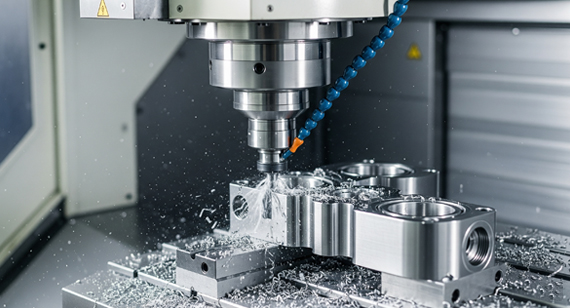
When Should MC66 Steel Be Used?
MC66 steel is ideal for applications that demand exceptional hardness, superior wear resistance, and long-lasting edge retention. Its properties make it a prime choice for:
In summary, MC66 should be selected when maximum hardness and wear resistance outweigh the need for corrosion resistance or extreme toughness.
When Should SG2 Steel Be Used?
SG2 steel excels in environments requiring a balanced combination of toughness, corrosion resistance, and good hardness. It is particularly suitable for:
SG2 steel is best chosen when corrosion resistance and toughness are priorities without sacrificing too much hardness.
In conclusion, the choice between MC66 and SG2 steels depends on the specific demands of the application. For ultra-hard, wear-critical parts, MC66 steel is the superior choice. For tough, corrosion-resistant, and versatile applications, SG2 steel offers an optimal solution. Partnering with experienced CNC machining factories ensures these materials are processed to their full potential, delivering quality and performance in every part.
Here is a clear comparison table to help choose between MC66 steel and SG2 steel based on their ideal applications and usage scenarios:
| Criteria |
When to Use MC66 Steel |
When to Use SG2 Steel |
| Primary Strength |
Exceptional hardness and superior wear resistance | Balanced toughness and excellent corrosion resistance |
| Ideal Applications |
Cutting tools, industrial blades, precision dies | Kitchen knives, surgical instruments, marine and food processing equipment |
| Environmental Suitability |
Dry or controlled environments | Humid, wet, acidic, or marine environments |
| Mechanical Stress |
High abrasion, repetitive friction | Impact, flexing, dynamic loads |
| Corrosion Resistance Needs |
Moderate | High |
| Ease of Sharpening |
Difficult to sharpen | Easier to sharpen |
| Machinability in CNC |
Requires advanced tooling and precise machining parameters | Better machinability due to fine microstructure |
| Typical Industries |
Aerospace, heavy machinery, medical tooling | Food service, healthcare, marine equipment, outdoor tools |
This table provides a straightforward guide for selecting the appropriate steel type for your steel CNC machining parts or specialized components through CNC machining services.
Selecting the right steel for knives is essential to ensure optimal sharpness, durability, corrosion resistance, and ease of maintenance. Both MC66 steel and SG2 steel are recognized as premium knife steels with distinctive qualities that appeal to different types of knife users and applications. Understanding their suitability helps manufacturers, knife makers, and buyers make informed choices when choosing materials for steel CNC machining parts in knife production.
Is MC66 Steel Good for Knives?
MC66 steel is highly regarded for its exceptional hardness and edge retention, making it a favorite among manufacturers of high-performance knives. Its composition allows knives made from MC66 steel to maintain a sharp edge for extended periods, even under heavy use. This makes it ideal for tactical knives, industrial cutting tools, and surgical blades where precision cutting and wear resistance are paramount.
However, MC66 steel’s hardness also means it can be more brittle and prone to chipping if subjected to sudden impacts or flexing. Additionally, its moderate corrosion resistance requires careful maintenance and proper storage to prevent rust, especially in humid environments. For users who prioritize maximum cutting performance and durability and are willing to invest time in upkeep, MC66 steel knives are an excellent choice.
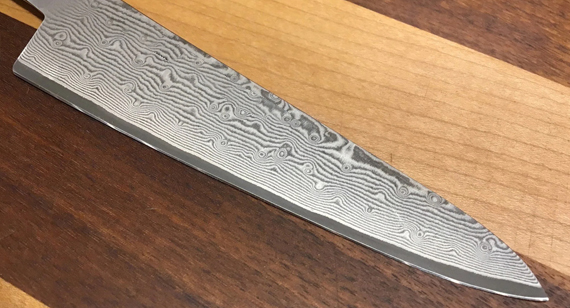
Is SG2 Steel Good for Knives?
SG2 steel is widely celebrated in the knife-making community for combining high hardness with excellent toughness and corrosion resistance. Produced via powder metallurgy, SG2 has a fine and uniform microstructure, which gives knives superior edge stability and ease of sharpening.
This steel excels in kitchen knives, culinary tools, and outdoor knives, where exposure to moisture and frequent sharpening are common. Its corrosion resistance helps prevent rust and stains, making SG2 knives more low-maintenance compared to MC66. Furthermore, SG2’s toughness reduces the likelihood of chipping, even during heavy use.
Overall, SG2 steel is suitable for those who need durable, corrosion-resistant knives with balanced performance and relatively easy maintenance.
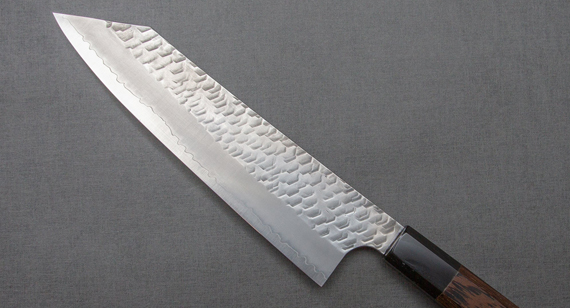
Summary
Both MC66 steel and SG2 steel are excellent materials for knife manufacturing, but they serve slightly different needs:
| Steel Type |
Suitability for Knives |
Key Strengths |
Considerations |
| MC66 Steel |
Best for high-performance knives requiring long-lasting sharpness | Exceptional edge retention and hardness | Requires careful maintenance; more brittle |
| SG2 Steel |
Ideal for kitchen, culinary, and outdoor knives with exposure to moisture | Balanced hardness, toughness, and corrosion resistance | Easier to sharpen; more corrosion-resistant |
Choosing between MC66 steel CNC machining parts or SG2 steel CNC machining parts depends on the specific knife use case, environmental conditions, and maintenance preferences. Both materials are trusted by CNC machining factories worldwide for producing top-quality knife components.
In today’s competitive manufacturing landscape, precision, quality, and reliability are paramount—especially when it comes to stainless steel CNC machining parts. VMT stands out as a premier CNC machining factory specializing in stainless steel components, delivering exceptional service tailored to diverse industrial needs.
With advanced CNC machining technologies and a skilled workforce, VMT ensures every part meets stringent standards of accuracy and durability. Whether clients require prototype development or mass production, VMT’s comprehensive CNC machining services cover milling, turning, drilling, and finishing, all optimized for stainless steel materials, including specialty steels like MC66 and SG2.
VMT’s expertise extends to producing MC66 steel CNC machining parts and SG2 steel CNC machining parts, leveraging deep material knowledge to handle the unique machining challenges these premium stainless steels present. The factory’s commitment to quality control, timely delivery, and competitive pricing makes it a trusted partner for sectors such as aerospace, medical, food processing, and tooling industries.
By combining cutting-edge equipment with rigorous process management, VMT consistently delivers stainless steel CNC machined parts that meet or exceed customer expectations. Clients benefit from personalized support, technical consultation, and the assurance that their components will perform reliably in demanding applications.
For manufacturers and designers seeking a dependable source for high-quality stainless steel CNC machining parts, VMT represents a factory dedicated to precision, innovation, and customer satisfaction.
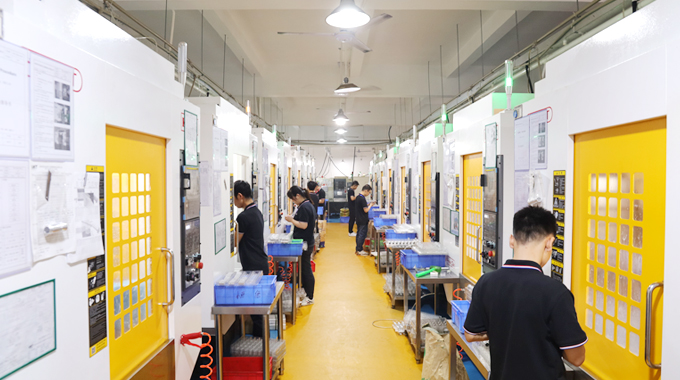
In the comparison between MC66 steel and SG2 steel, both materials demonstrate exceptional qualities tailored to specific industrial needs, especially in the realm of steel CNC machining parts. MC66 steel excels in hardness, wear resistance, and edge retention, making it the preferred choice for applications demanding maximum durability and precision cutting performance. On the other hand, SG2 steel offers a superior balance of toughness, corrosion resistance, and machinability, which is ideal for environments where maintenance ease and resistance to harsh conditions are critical.
Choosing between MC66 and SG2 steel ultimately depends on the specific requirements of the project—whether the priority is on hardness and longevity or toughness and corrosion resistance. Both steels, when processed by experienced CNC machining factories like VMT, can deliver outstanding results tailored to high-performance industries including aerospace, medical, food processing, and tooling.
By understanding the distinct chemical compositions, mechanical and physical properties, heat treatment processes, and cost implications of MC66 and SG2 steel, manufacturers and engineers can make informed decisions that optimize both product quality and lifecycle value. Partnering with a professional CNC machining service provider such as VMT ensures precision, reliability, and efficiency in producing stainless steel parts that meet the highest standards.
Ultimately, whether it’s MC66 steel CNC machining parts or SG2 steel CNC machining parts, selecting the right steel coupled with expert machining services is key to achieving superior product performance and customer satisfaction.
1. Is SG2 a good knife steel?
Yes, SG2 is considered an excellent knife steel due to its high hardness, excellent corrosion resistance, and good toughness. It is widely used for high-end kitchen and culinary knives.
2. What is the highest quality steel for kitchen knives?
The highest quality steels for kitchen knives often include powder metallurgy steels such as SG2, S30V, and VG-10, which balance hardness, edge retention, and corrosion resistance.
3. What type of steel is SG2?
SG2 is a powdered metallurgy stainless steel known for its fine grain structure, high hardness (typically 60–62 HRC), and excellent corrosion resistance.
4. What is the best stainless steel for making knives?
The best stainless steels for knives are typically powder metallurgy grades like SG2, S30V, and CTS-XHP, which offer a good balance of toughness, hardness, and corrosion resistance.
5. Is SG2 worth it?
Yes, SG2 is worth it for users who require knives with exceptional sharpness, durability, and corrosion resistance, especially in demanding environments.
6. Does SG2 rust-proof?
SG2 is highly rust-resistant but not completely rust-proof. Proper maintenance helps maintain its corrosion resistance.
7. What is the best non-rusting steel?
316 stainless steel is one of the best for corrosion resistance, especially in marine environments. For knives, PM stainless steels like SG2 also offer excellent rust resistance.
8. What is the difference between S30V and SG2?
S30V is a popular stainless steel known for balanced toughness and edge retention, while SG2 generally offers higher hardness and superior corrosion resistance due to its powder metallurgy process.
9. Which grades of steel are rust-proof?
No steel is completely rust-proof, but grades like 316 stainless, SG2, and other PM stainless steels offer very high corrosion resistance.
10. Does 316 steel rust?
316 stainless steel is highly resistant to rust and corrosion but can corrode under extreme conditions if not maintained properly.
11. What is MC63 steel?
MC63 is a high-carbon stainless steel similar to MC66, designed for high hardness and wear resistance, often used in knives and precision tools.
12. What is the hardness of SPG2 steel?
SPG2, another name for SG2, typically has a hardness of 60–62 HRC after proper heat treatment.
13. Which steel is better for knives?
The best steel depends on use: MC66 excels in edge retention and wear resistance; SG2 offers a better balance of toughness and corrosion resistance.
14. Is SG2 difficult to sharpen?
SG2 is easier to sharpen than ultra-hard steels like MC66, thanks to its fine microstructure from powder metallurgy.
15. What is the difference between chrome-molybdenum steel and steel?
Chrome-molybdenum steel is an alloy steel containing chromium and molybdenum for enhanced strength and corrosion resistance, while “steel” is a broad term covering many alloys.
16. What is fire retardant coating on steel?
It is a protective coating applied to steel surfaces to improve fire resistance by slowing heat transfer and oxidation during exposure to flames.
17. Is S30V better than Elmax?
Both are high-quality steels; S30V is known for toughness and edge retention, while Elmax offers slightly better corrosion resistance and ease of sharpening.
18. Is A2 tool steel good for making knives?
A2 is a good air-hardening tool steel with good toughness and edge retention but lower corrosion resistance, so it requires more maintenance for knife use.
